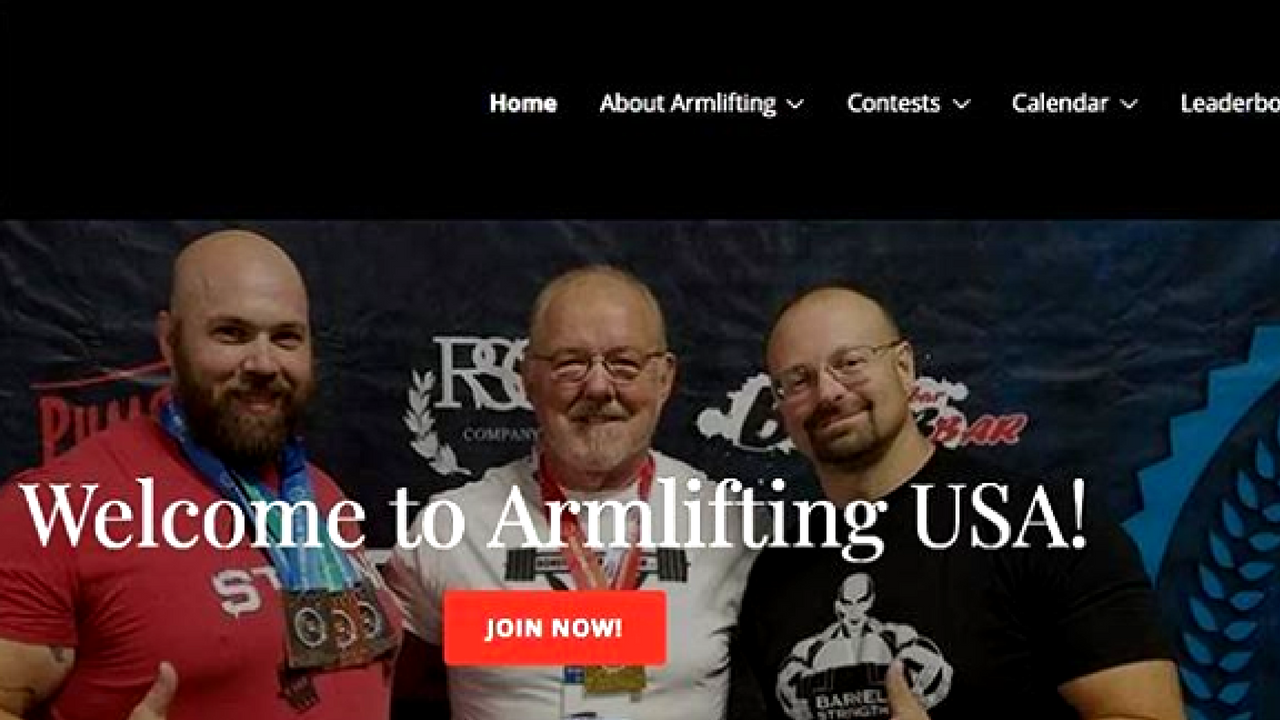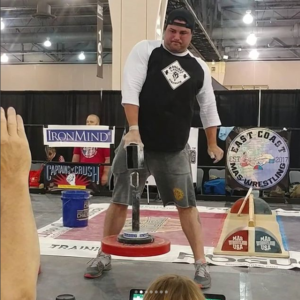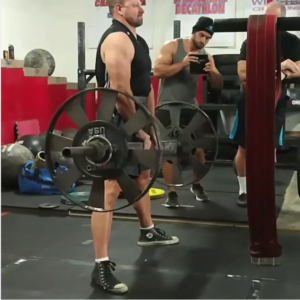
Armlifting began to catch my attention early in 2018 as I began looking for non-traditional sports that home gym athletes could pursue. I was already interested in grip strength as part of my discovery of physical culture so when I began to hear about a new sport, sponsored by IronMind Enterprises, that you could pursue in conjunction with your current athletic goals, I had to know more! Riccardo Magni, Secretary General of Armlifting USA, Odd Haugen, Chairman of the Board of Armlifting USA and Randall Strossen, founder of IronMind Enterprises were good enough to share their knowledge of this sport with us. Let’s dive in!
Armlifting began as a sport in 2000 is that correct?
Riccardo: Randy Strossen has corrected our description of Armlifting.
“Armlifting was born in 2010, when a Russian armwrestling promoter asked IronMind for permission to organize grip contests featuring the Rolling Thunder, dubbing the competitions Armlifting. So, armlifting is the Russian name for grip contests that began with the Rolling Thunder, and have since come to include such other grip world staples as the Apollon’s Axle Double Overhand Deadlift and CoC Silver Bullet Hold. “
I don’t mind being corrected by someone as knowledgeable as Randall Strossen! I’ve been a fan of his work since shortly after I got into training! So armlifting began in 2010, I know that athletes such as Jerome Bloom have recorded multiple grip world records but was this the first official grip competition?
Riccardo: The first official contest using Ironmind equipment was the Rolling Thunder World Championships in 2000. It is possible that David Horne in England held a contest before that, but as far as I know, this is the first contest.
Randall: I believe David Horne’s grip contests started in the early-to-mid 1990s and there were International All Round Weightlifting Associaton (IAWA) grip contests at least that far back, too, but you could confirm that with David and he’d be the first person I would turn to with a question related to grip history.
Briefly describe the events contested in a typical Armlifting competition.
Riccardo: Armlifting USA contests consist of 2 out of the following 3 events: Rolling Thunder, Apollon’s Axle, and the Silver Bullet.
Except for the Country Crush, most of the events are based on IronMind products. IronMind has a solid reputation across multiple strength sports but are there any plans to add products from other manufacturers such as Grip N Bend the makers of the Dube Cube?
Riccardo: We have already added many other products to the contests. For example, on July 14, 2018, the Hands of Doom contest in Sacramento featured the 2” Excalibur (a homemade replica) and the 2 Hand Flask lift from Barrel Strength Systems.

Are there weight classes in Armlifting USA or only men’s and women’s classes?
Riccardo: In Armlifting USA, we have adopted the same weight categories as the APL (Armlifting Professional League in Russia). For men, those are 70kg, 80kg, 90kg, 100kg, 110kg, 125kg, and 125kg+. For women, we have 60kg, 80kg, and 80kg+.
I see athletes like Jedd Johnson, doing Blob lifts and other grip feats in competitions. What’s the difference between Armlifting and Gripsport?
Riccardo: Gripsport is more of a random distribution of Grip events. It may contain whatever the contest director wants. Armlifting USA says that for a contest to be sanctioned by Armlifting, USA, it must have two of the following three events: Rolling Thunder, Apollon’s Axle Double Overhand Deadlift or Silver Bullet. This is the case internationally as well. That said, Armlifting USA contests are not limited to those events and can certainly contain other events with other equipment.
The key is that the exercises are the same. This may prove to be attractive to newcomers to the sport because they will know what to expect for each contest and will also keep their start up costs down.
Some of the events hearken back to the era of strongmen like George Jowett and his anvil lifting feats. It’s sad that so many historical grip feats have been forgotten – how much does Armlifting USA do to recognize the accomplishments of old time strongmen?
Riccardo: I think Apollon’s Axle is a perfect event to help recognize the old-time strongman. The Thomas Inch dumbbell lift is another one (although many people can’t do it) definitely gives homage to Thomas Inch. The Saxon bar lift is another one that pays tribute to Arthur Saxon.
Randall, since IronMind has such a rich tradition of honoring the legacy of these old time strongmen and women, was that part of the motivation to support creating a new sport?
Randall: IronMind was founded in 1988 and from its earliest days IronMind was grip central, and a big part of our efforts has been to shine a spotlight on feats of strength that might otherwise not get much attention—when he read about MILO calling it a day after 25 years, a leading grip contest competitor said to me, “I wanted to send you a personal thank you for always covering the niche sports that only a hand of us cared about. It always made me feel like a big shot to see my name and picture in print. Thank you for 25 years of turning little guys into rock stars.”
As a brief aside, MILO was one of the inspirations behind what Garage Gym Life. While we focus on home gym owners, many of those who train at home also happen to be champions in various sports. The average newsstand publication looks at home workouts as something you do with two cans of soup for weight because you can’t get to a real gym. So I think it’s important to highlight sports like armlifting that might not get “mainstream” attention because so many of us who train at home feel alone and might not realize that there are outlets for their competitive desires that go beyond what they see.
Most of the events seem to require specialized equipment, like any other strength sport. Home gym owners, and garage gym owners in particular, tend to lean towards the DIY side of things. What are the advantages of buying equipment versus simply looking up the specs and making your own?
Riccardo: The advantage to buying equipment is simple: if you go to a contest, you will be ready to use the actual equipment you’re using in the contest. If you’re using homemade stuff, it may not be exactly the same and you may not have the performance you’re looking for.
Randall: IronMind encourages people to improvise, be wise consumers and never to let lack of [good] equipment be a hindrance to one’s training. On the other hand, while you can get a local stone or cast something out of concrete, it’s not going to be the Inver Stone, so if you want to lift the Inver Stone, that’s what you have to do. Fortunately, IronMind grip products are not hugely expensive, they should last a very long time and they are widely found in home gyms (and other places) worldwide, so if you don’t have your own Rolling Thunder, for example, a guy nearby might and maybe the two of you can figure out a way to train together,
I mentioned Jerome Bloom who is not a large person. For anyone who might be concerned about hand size being a limiting factor in their success in the sport, how big a role does hand size play in grip strength and is this something that can be overcome through training or are you pretty much stuck with what you were born with?
Riccardo: Hand size is a huge factor in Armlifting. Typically bigger is better. Of course, it depends on the events. Hand span is also an issue, especially in picking up block weights. Jerome is a fantastic lifter but he does specialize in the events that are more suited for smaller hands. And his results in those events are truly outstanding. I think that you have go with what you were born with. That said, you can strengthen your wrists and fingers quite a bit. Like anything, it takes time.
Besides, Jerome, who would you say are the current “superstars” in the world of grip that people might want to follow on social media?

Instagram is the place to be for watching daily grip training footage!! I think Harri Tolonen from Finland is probably the best guy right now. Thomas Larsen from Norway is another one: absolutely fantastic. Alexey Tyukalov, he is on YouTube, from Russia is also very strong and competes in the US frequently. Carl Myerscough from England and Eric Roussin from Canada are amazing, but not as active on social media. Odd Haugen is absolutely immense at 68 years old. Clay Edgin is good at every single grip feat there is; from grippers to rolling up frying pans, he literally has done it all. Arto Joronen from Finland is a monster and posts lots of training footage. When he is not on vacation, Roman Penkovskiy is the current Russian Rolling Thunder champion.
Tanner Merkle, Jesse Pynonnen, and Alexander Filiminov are up-and-coming superstars. On the female side, Julia Williams is super strong! Hannah Jennings is another is very powerful female athlete, especially at bending steel.
Armlifting is often overshadowed by other strength sports; you don’t see grip champions being interviewed on most podcasts for example. What do you think it will take to bring Armlifting more recognition?
Riccardo: I think it will take time for Armlifting to get more recognition. I appreciate the work that you are doing and giving us a little bit of air time, so to speak. At our Fit Expo competitions, we do have Pro Strongman who take part in the contests. Having the opportunity to compete with Martins Licis or Mark Felix should get you excited!
Armlifting USA puts on the Vice Grip Viking events at the Anaheim, Ft. Lauderdale and Los Angeles Fit Expos. Is Armlifting USA affiliated with the GNC Grip Gauntlet held annually during the Arnold Fitness Expo?
Riccardo: No, we are not affiliated with GNC but we are actively looking to get Armlifting going at the Arnold Classic.

IronMind has contributed a lot of footage to strength sports over the years. Are there plans to livestream Armlifting events the way powerlifting, strongman and now Highland Games are covered online? Maybe on the IronMind YouTube channel?
Randall: Only if we find a capable person to be on the ground for us—ready to film, edit and post.
Riccardo: Odd Haugen has livestreamed the last few events that we have held on his Facebook page. For California’s Strongest Hands, we got over 15,000 views. That is definitely a good start.
Describe the process of getting the sport added to the competition roster at a Fit Expo. How long did it take, is there a certification process for the federation? etc.
Odd: There was no process, the Armlifting was added as an extension of the Strongman events.
Odd, having been involved with the sport of strongman for so many years, what attracted you to try your hand at a new strength sport?
Odd: It’s a great unloader of weight (overload) on the body, in that you can make max lifts without the accompanying risks.
Riccardo, you mentioned in a message to me that you’ve traveled to Russia and are heading to Finland to compete in Armlifting. Traveling to compete is a dream of many people, some of whom might be better served to compete in a sport like Armlifting rather than chasing the dragon in Olympic lifting or powerlifting. Someone who’s got a strong deadlift for example but isn’t as good at the squat and bench comes to mind for example.
Riccardo: I agree 100 percent. You’ll never know unless you try the sport!!
It seems that Armlifting faces a dilemma similar to Mixed Martial Arts in that although training for this sport can coexist with training for other strength sports, people might believe that it  would interfere with their chances of being great in their current sport. How do you reach out to athletes in other strength sports to encourage them to give Armlifting a try without making it seem like you’re trying to steal them away?
would interfere with their chances of being great in their current sport. How do you reach out to athletes in other strength sports to encourage them to give Armlifting a try without making it seem like you’re trying to steal them away?
Riccardo: That is an excellent question. We just held a contest in Sacramento at a primarily Olympic lifting gym. All of the people there loved the grip. And now they’re thinking of hosting a second contest!! It’s that simple: unless you try it you don’t really know how fun it is! I think the key is for multi-sport athletes to do the grip training in moderation. That’s easy for me to say because several days a week I do double workouts but I’m only focusing on the grip.
One reason that I am passionate about Armlifting is because there are a variety of challenges to it. Lots of different implements. Lots of areas to improve. This is a sport that ANYONE can train safely in their garage if they know the proper lifting techniques. At some level, all you need is a carabiner, and bunch of attachments, and a pile of plates to get started. I hope that after reading this article, other people will want to give it a try.
A lot of equipment innovation is linked to real world needs. Has the growth of Armlifting led to any tweaks in IronMind equipment or plans to create new pieces of training equipment for Armlifting competitors?
Randall: Grip paraphernalia can be multiplied ad infinitum so that’s no challenge. Instead, the challenge was to distill the core events critical to define the sport/feat of strength and then standardize them so that people worldwide over significant periods of time could perform on level ground. This is how you build legitimacy in the athletic world: In track, for example, if you think you’re fast, you run the 100-meter dash. If you want to pretend you’re better than you are, you could find someone to hold, for example, the 87-meter dash, and then you could tell your friends that you just won the event and set a world record. This is, basically, how powerlifting destroyed its legitimacy, and the challenge for grip contest promoters is to avoid falling into the same trap.
Say someone wants to get involved in Armlifting, how would they find a competition?

93.5kg (206.1#) for a ride
Riccardo: The best place to find information about Armlifting to go to a website at www.armliftingusa.com. Yearly membership is $20. That’s pretty low compared to powerlifting and strongman.
That’s the definite truth! Are there individual competition fees as well as an annual membership fee?
Riccardo: Entry fees range from free all the way to $100. Typically the expensive ones use that money as prize money.
Where can a novice go to get training instruction (besides the old school physical culture books of course!)
Riccardo: There are a lot of resources on Instagram for armlifting. One thing would be to simply follow the hashtag #armlifting. Another thing would be to find an experienced competitor and try to train with them. Another option would be to go to a seminar on arm lifting. Odd Haugen and I are going to be giving a seminar in San Diego on October 28th at the San Diego Fit Expo. We gave one in Philadelphia that was extremely popular. At one point there were 20 people on the stage up there trying different implements. There is no way to recreate the type of energy; it was fantastic! Some people are offering programming of training online. I am one of them and can be contacted on my email or by Instagram.
How about training videos? Will IronMind provide training videos for aspiring armlifters to purchase?</h/5>
Randall: Not for sale, but IronMind already has some how-to/informational videos on our YouTube channel and vital grip training resources in the form of multiple booklets are available free on www.ironmind.com
That’s fantastic information! I’ll put those links in the Intro to Armlifting video that Riccardo recently did for the Garage Gym Life YouTube channel.
[…] Features […]
[…] Features […]